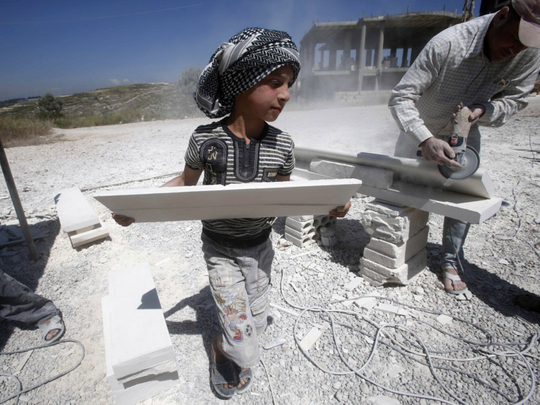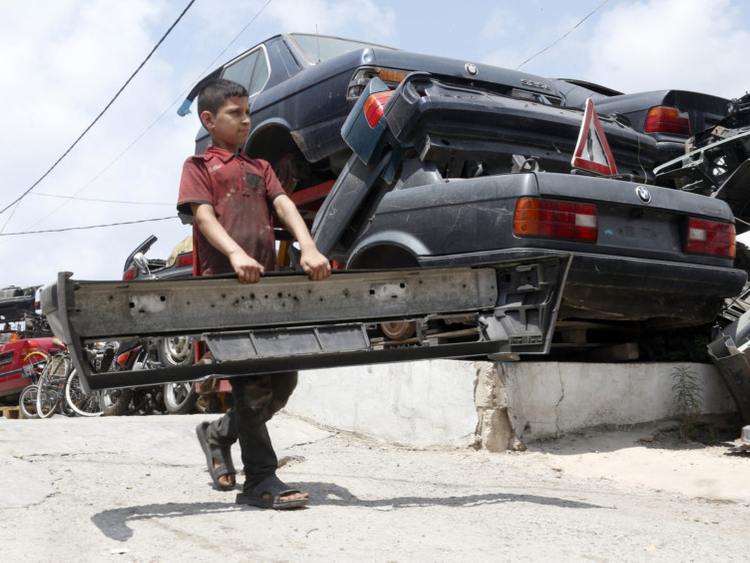
Raqqa: The 12-year-old cousins from Raqqa were taking a rest after their five-hour shift in the lettuce field. It was early afternoon, a light breeze taming the July sun, and it was time for them to go home to their tents. It’s not yet the season to harvest the cannabis in the neighbouring field - that will have to wait until September.
“You saw what it’s like,” said one of the boys, a shy smile rarely absent from his tanned face, after hours bent over in the field. “We’d like to go to our country. We’re exhausted working on the lettuce, but we’re used to it now.”
It’s normal, they said, for them to work. “They need the workers so their project doesn’t fail,” said the other boy, laughing as he ran off after a dozen other teenage labourers piling into the pickup truck that would take them home.
All the youngsters here, aged between seven and 20, are from Syria and earn about $8 a day for 10 hours’ work in the fields of Lebanon’s Bekaa Valley, the agricultural hinterland that abuts the Syrian border.
Thousands of Syrian children have become farm labourers in vegetable fields and warehouses, the destitution and misery of their displacement prompting them to enter a workforce where they are subject to abuse and exploitation. Many skip school to provide for their families, becoming adults before their time.
Street children are a fixture in the capital, Beirut, hawking goods, begging, shining shoes and selling flowers at night to bar customers, risking the occasional beating and frequent verbal abuse. Most sleep rough and some turn to prostitution, the highest-paid occupation in local child labour.
But in the Bekaa, large numbers of children have been drafted into the agricultural sector, part of what experts warn could be a lost generation - with minimal prospects as they miss out on years of education because of the continuing cataclysm in Syria.
Women and children make up close to 80% of Syrian refugees in Lebanon, and roughly half of them have been displaced more than once inside Syria, arriving impoverished and destitute.
A total of two million Syrian children have sought refuge from the war outside their country. Around 2.7 million Syrian children are currently out of school, according to a recent joint report on child labour from Save the Children and Unicef.
Nearly half of Syrian refugee households in Jordan say they rely partly or entirely on children’s income. But the children risk health problems and psychological distress, the report says - three-quarters of working children in Jordan’s Zaatari refugee camp reported poor health, and 36% of working children in the Bekaa Valley are illiterate.
“The Syria crisis has dramatically reduced family livelihood opportunities and impoverished millions of households in the region, resulting in child labour reaching critical levels,” said Roger Hearn, Middle East and Eurasia director for Save the Children. Many are exposed to pesticides, toxic chemicals, heavy loads and exhausting hours, the aid agency said: “Syria’s children are paying a heavy price for the world’s failure to put an end to the conflict.”
Khaled, another 12-year-old boy, said his parents were too poor to send him to school. Instead he toils in the fields for two five-hour shifts when the work is available, earning the equivalent of $4 for each shift.
The money goes to support his parents and six siblings in their refugee settlement - three of the children are too young to work.
“The kids are faster, and when you have a house with 10 children, six of them big and four small, well, the big ones carry the small ones so they can live,” said one of the farmers who works with child labourers.
These children’s day begins before sunrise, when a Syrian foreman collects them from the camps strewn across the Bekaa Valley.
Early on in the Syrian crisis, the chronically dysfunctional Lebanese government decided it was political dynamite to build official refugee camps, so the displaced are left to live in makeshift tent settlements and shelters in the countryside.
The government was wary of building permanent dwellings for the refugees - the country has a delicate sectarian balance that would have been overwhelmed by an influx of mostly Sunni civilians fleeing the war.
The Palestinian refugee camps built in the 1940s and 1950s after the establishment of the state of Israel are still home to more than 400,000 Palestinians who played a key role in the country’s 15-year civil war.
The arrangement has meant that many Syrian refugees have entered the workforce. The vast majority are women or children, and many of the men are infirm and are anyway legally barred from work, at the risk of incurring large fines for doing so.
Not all the children have become labourers because of the war, though that has vastly boosted their numbers. Many, from Raqqa in particular, often travelled to Lebanon in summer to work in the fields, earning some money before returning home for school. Now Raqqa is Daesh’s seat of power, and many of the children have stayed in Lebanon, working all year in fields and produce warehouses. Some go to local “tent schools” established by Unicef in collaboration with local NGOs, but many skip classes to work in the fields and feed their families.
“The children have become used to it - most work from when they’re eight,” said one of the local foremen. “They wake at 5am and finish work at 8pm, wash and sleep. That’s their life.” But it is hard to get used to working for 10 hours in the scorching sun or biting cold of the Bekaa Valley. Aisha, 20 - her name has been changed, like those of others quoted here - has been working in the fields for 10 years, but said she stayed at home last week after going down with heatstroke.
“We adapted because we have no other work,” she said, taking a break from shovelling soil around lettuce heads. Nearby, in addition to the cannabis field, are onion, almond and okra orchards.
Aisha works with two of her sisters, one of whom was on the verge of finishing high school when the war broke out. Now none of them goes to school or college - their parents are too old to labour now. “Five hours for $4 is unfair,” she said, adding that most of the money goes to buying dough to make bread because they can’t afford much in the way of vegetables. Dinner is often bread and fried potatoes. “I just want to rest. Our life is all work,” she said.
They seem to have a healthy rapport with their employers, who laugh and joke with the children, but Aisha said it’s not always that way - her previous employer would often mistreat the children if they took so much as a few minutes’ rest. “This employer is a kind person, but others were not,” she said. “They would treat us like cattle.”
Ali, a local farmer, said he tries to reduce the children’s work hours or give them additional money on occasion, and at least they do not have to carry very heavy loads, but he said they had no choice but to hire the youngsters.
Lebanon imposed very cumbersome entry requirements on refugees this year, which have slashed the number of new arrivals from Syria, despite the ferocity of the war. Beyond the humanitarian burden, Lebanon’s infrastructure is stretched to breaking point. It has the highest per capita refugee population in the world, with 1.1 million registered with the UN High Commission, out of a total prewar population of four million. The country has nearly reached its projected population levels for 2050. “There are no older people,” Ali said. “The border is closed and they need sponsors. Who’s going to sponsor them? Everybody who can, works.” He added: “It’s the war that has made them start out this early.”













